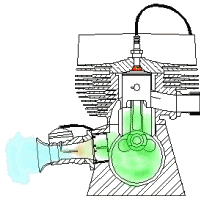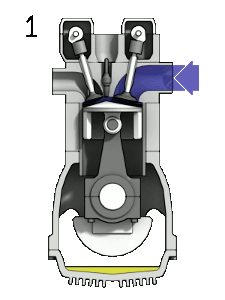Why SeWa Sea Wave Four-Stroke Outboard Motors
It depends on whose numbers you believe, but anywhere from 70% to 80% of all outboard motors sold in the world are now four-strokes. The majority of countries outlaw the sale of two-stroke engines, including Nigeria, see Nigerian National Environmental Regulations.
Two-Stroke Engines
 A two-stroke is a type of internal combustion engine initially favored in Outboard Motors (OMs) which completes a power cycle in only one crankshaft revolution and with two strokes, or up and down movements, of the piston in comparison to a "four-stroke engine", which uses four strokes to do so. This is accomplished by the end of the combustion stroke and the beginning of the compression stroke happening simultaneously and performing the intake and exhaust (or scavenging) functions at the same time.
A two-stroke is a type of internal combustion engine initially favored in Outboard Motors (OMs) which completes a power cycle in only one crankshaft revolution and with two strokes, or up and down movements, of the piston in comparison to a "four-stroke engine", which uses four strokes to do so. This is accomplished by the end of the combustion stroke and the beginning of the compression stroke happening simultaneously and performing the intake and exhaust (or scavenging) functions at the same time.
The crankcase-scavenged engine, employing the area below the piston regulated from atmosphere by a read valve as a charging pump, means that there can be no sump containing lubricating oil. Lubrication is achieved by mixing two stroke oil with the petrol (fuel) normally in the ratio of 50:1 which is then known as petroil. To reduce the high emissions and oily deposits on spark plugs two stroke outboards should use special oil (to specification ISO-L-EGO) with low ash content. This is required also to minimize deposits that tend to form if ash is present in the oil which is burnt in the cylinder.
Power-to-Weight Ratio
Two-stroke engines provide high power-to-weight ratio, in a narrow range of rotational speeds called the "power band", and, compared to four-stroke engines, have a greatly reduced number of moving parts, they are more compact and significantly lighter and less expensive. The need for a two-stroke engine to operate in its power band makes it necessary to match the propeller to the application.
Petrol (spark ignition) two-stroke engines were particularly useful in lightweight (portable) applications such as chainsaws, generators, waterpumps, multipurpose engines, and outboard engines. The concept is also used in diesel compression ignition engines in large and weight insensitive applications, such as ships, locomotives and electricity generation. The heat transfer from the engine to the cooling system is less in a two-stroke engine than in a traditional four-stroke, a fact that adds to the overall engine efficiency; however, traditional two-strokes have poor exhaust emissions.
Environmental Pollution & Governmental Regulation
Small engines, such as conventional two-stroke engines used in marine outboard motors are high polluters relative to their engine size and usage. These small engines emit volatile organic compounds (VOCs) and oxides of nitrogen (NOx) which contribute to ozone (photochemical smog) formation in the dry season. They also emit particles, carbon monoxide (CO) and a range of water and air toxics such as benzene.
The Federal Government of Nigeria (FGN) introduced two emissions regulations, National Environmental (Wetlands, Riverbank, and Lake Shore) Regulations 2009 and the Nigerian National Environmental (Control of Vehicular Emissions from Petrol and Diesel Engines) Regulations 2011 both of which SeWa Sea Wave four-stroke engines comply with. On the other hand some overseas manufacturers still produce high emissions two stroke marine outboard engines to sell in unregulated markets.
Two-stroke outboard engines that do not comply with the regulations limits are likely to emit around ten times the amount of pollution compared to conforming four-stroke engines. This is due to their inability to completely separate the inlet gases from the exhaust gases, resulting in up to 30% of the fuel being left unburnt, plus the need to add oil to the fuel to lubricate the engine. However, two-stroke carburettor engines typically weigh less than a four stroke engine of the same power they also have fewer components, are cheaper to buy and have lower maintenance costs compared to four-stroke engines.
Substantial engine power is required to overcome the high resistance encountered when pushing a boat through water. As a result, even the better performing outboard engines emit significantly higher levels of air pollutants than do typical modern car engines, when assessed in hours of operation or kilometres travelled. For example, the US Environmental Protection Agency’s (USEPA) 2006 limit for a 40hp outboard motor is about 2 kilograms (kg) of regulated pollutants per hour of operation. The equivalent limit for cars is less than 1 gram per kilometre or about 40 grams per hour. In other words, one hour of operation of a boat, with a relatively clean engine, produces the same pollution as about fifty cars, operated at a similar speed!
Studies have revealed that most hydrocarbons discharged onto the water surface as petrol, evaporate to air within six hours, further adding to the air pollution load. However, heavier hydrocarbons, such as oil and grease, remain on the surface for a longer period of time and may affect the health of microscopic organisms. Because of the combustion of two-stroke oil, two-stroke engines also emit high levels of particles.
Although small engines only contribute a small amount to total particle emissions, the rate of particle release compared to other engines can be very high. Most outboard engines emit their exhaust gases into the water. It is known that two-stroke outboard engines emit 10-20% of the petroil mixture into the water as part of normal operations. Lower exhaust emissions will therefore also have a significant effect on reducing water pollution from boating.
Direct-Injection
Two-stroke direct injection outboard motors cycle is simple. Intake and exhaust passages are opened and closed by the piston skirt as it pumps up and down in its cylinder bore. Unlike a conventional, original design, two-stroke, with a four-stroke no fuel is carried into the combustion chamber to inadvertently spill out into the exhaust port. Instead, fuel injects directly into the combustion chamber in a precise amount and at the split second required.
A direct-Injected outboard has neither crankcase oil nor oil filter. Instead, a precisely metered stream of oil lubricates rings and bearings, burns off in the combustion chamber, and then exits along with the exhaust gas. Obviously this requires topping off the oil reservoir with every tankful of fuel (petrol), or in the case of some designs with large reservoirs, only periodically. The ratio of oil burned in the combustion chamber is minuscule and only minimally affects emissions. Admittedly, oil is a recurring cost.
Yamaha HPDI, Mercury OptiMax, Evinrude E-TEC, and Nissan TLDI engines are all direct-injected, yet each brand uses its proprietary method for inserting a plume of vaporized fuel directly into the combustion chamber. What they share in common is the way high-pressure injection shatters the fuel charge into micron-size droplets exposing a greater surface area to oxygen. The burn is cleaner so naturally it follows that a greater volume of fuel (petrol) converts into work (BTUs or joules). More work released per gallon of fuel equals better mileage and drastically reduces exhaust emissions. When the engine computer reacts to a helm command, fuel injects instantaneously into the combustion chamber, instead of waiting for a vacuum to draw it in. Therefore, throttle response is virtually instantaneous.
Four-Stroke Engines
 As for four-stroke outboard motors, manufacturers all build motors derived from decade’s worth of experience designing and building state of the art automotive engines. True to the genre, cylinder heads are liberally adorned with valves, springs, shims, keepers, valve lifters, camshafts, timing gears, belts and a crankcase sump of oil. With all those additional components, four-strokes tend to weigh from 10% - 20% percent more than an equivalent two stroke motor. On a 175hp OM that can add as much as 30 to 60 kilograms. This weight differential can adversely affect handling.
As for four-stroke outboard motors, manufacturers all build motors derived from decade’s worth of experience designing and building state of the art automotive engines. True to the genre, cylinder heads are liberally adorned with valves, springs, shims, keepers, valve lifters, camshafts, timing gears, belts and a crankcase sump of oil. With all those additional components, four-strokes tend to weigh from 10% - 20% percent more than an equivalent two stroke motor. On a 175hp OM that can add as much as 30 to 60 kilograms. This weight differential can adversely affect handling.
Smaller four-stroke OMs have carburettors, larger outboards are fuel injected, as opposed to direct injected. It is no surprise that four-stroke fuel-injection (FI) is modelled after the sophisticated multiport systems found on cars. With one injector per cylinder strategically positioned near the intake valve, FI four-strokes have excellent throttle response.
A four-stroke outboard lubricates its reciprocating components with oil pumped through engine passages. It is vital to change oil and the filter at least every 100 hours of operation. Otherwise there is the risk that dirty lubricant will destroy the bearings and crankshaft journals. It is safe to say four-stroke outboards are very sensitive to engine oil quality.
In addition to the technical differences between two-strokes and four-strokes, at lower rpm two-strokes are more powerful performers because they have a power stroke with every rotation of the crankshaft. Four-strokes only build power on every other up and down rotation of the crank. To compensate some OM manufacturers incorporate a lower gear ratio in the gear case. The lower the ratio, the more torque is multiplied narrowing the performance gap between two and four strokes.
Fuel Efficiency
Fuel economy on four-strokes engines measures from typically a 50% - 80% improvement, compared with two-stroke outboard motors. Depending on rpm and load at cruising speeds estimate about a 30% mileage improvement. Honda bestowed its expensive outboards with a particularly sophisticated valve train, one that varies timing. Advancing or retarding the moment when valves open and close in relationship to the crankshaft favours either low or high-end torque or strong acceleration.
The SeWa Sea Wave Deal
No matter what brand or type of OM you buy, in the final analysis what is most important is the deal. Chose a new SeWa Sea Wave which offers the best price, is legally compliant and has the most reputable parts & service department.
For more information and how to find your nearest dealer:
Tel: +234 90 3000 9393
Email: sales@sea-wave-outboards.com



